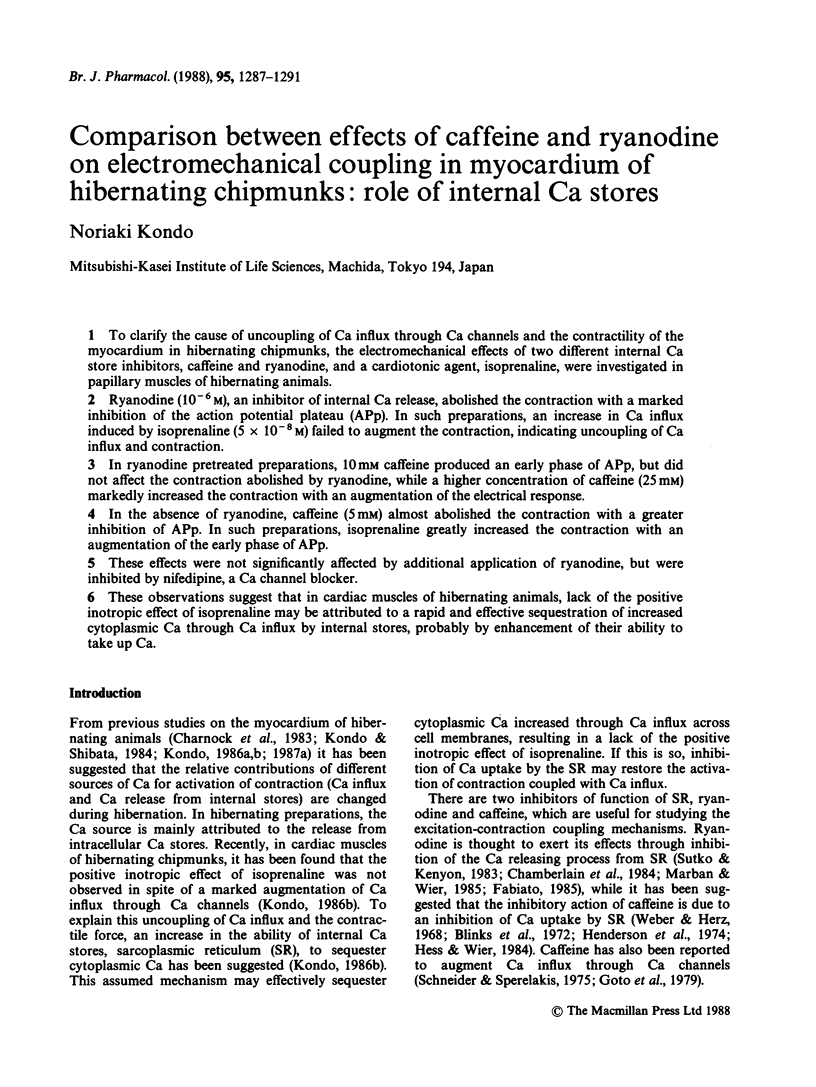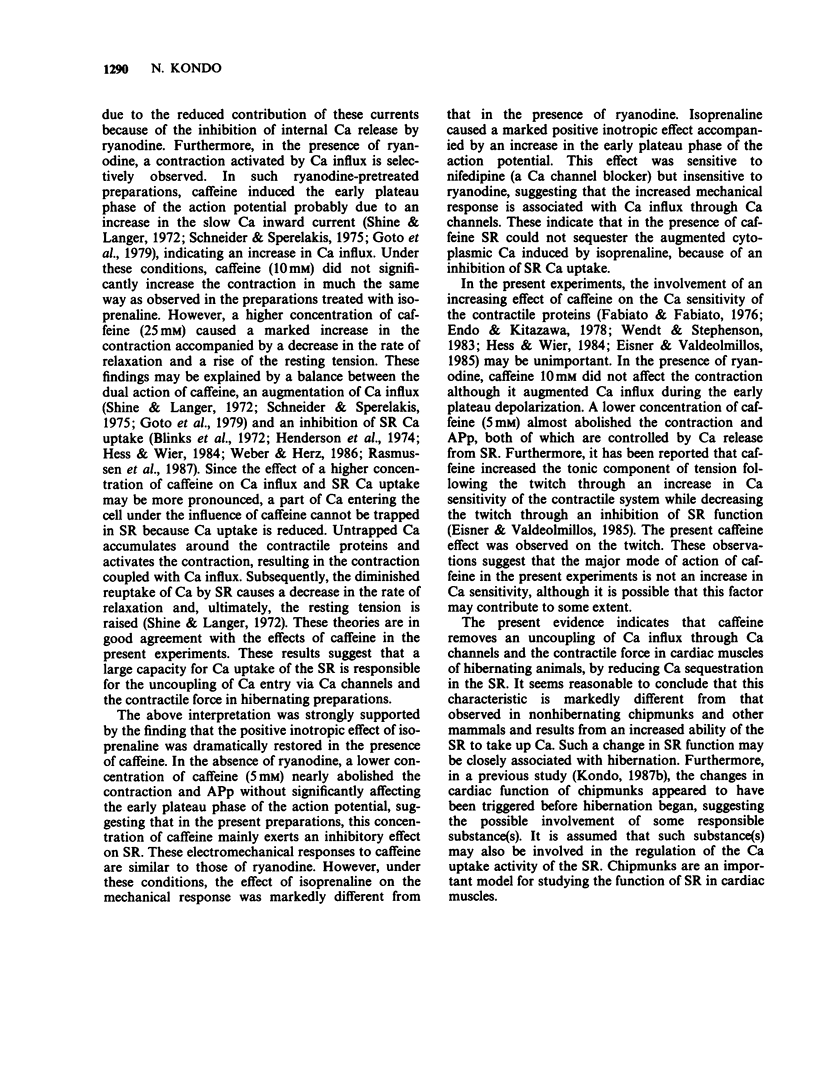Abstract
1. To clarify the cause of uncoupling of Ca influx through Ca channels and the contractility of the myocardium in hibernating chipmunks, the electromechanical effects of two different internal Ca store inhibitors, caffeine and ryanodine, and a cardiotonic agent, isoprenaline, were investigated in papillary muscles of hibernating animals. 2. Ryanodine (10(-6) M), an inhibitor of internal Ca release, abolished the contraction with a marked inhibition of the action potential plateau (APp). In such preparations, an increase in Ca influx induced by isoprenaline (5 x 10(-8) M) failed to augment the contraction, indicating uncoupling of Ca influx and contraction. 3. In ryanodine pretreated preparations, 10 mM caffeine produced an early phase of APp, but did not affect the contraction abolished by ryanodine, while a higher concentration of caffeine (25 mM) markedly increased the contraction with an augmentation of the electrical response. 4. In the absence of ryanodine, caffeine (5 mM) almost abolished the contraction with a greater inhibition of APp. In such preparations, isoprenaline greatly increased the contraction with an augmentation of the early phase of APp. 5. These effects were not significantly affected by additional application of ryanodine, but were inhibited by nifedipine, a Ca channel blocker. 6. These observations suggest that in cardiac muscles of hibernating animals, lack of the positive inotropic effect of isoprenaline may be attributed to a rapid and effective sequestration of increased cytoplasmic Ca through Ca influx by internal stores, probably by enhancement of their ability to take up Ca.
Full text
PDF




Selected References
These references are in PubMed. This may not be the complete list of references from this article.
- Blayney L., Thomas H., Muir J., Henderson A. Action of caffeine on calcium transport by isolated fractions of myofibrils, mitochondria, and sarcoplasmic reticulum from rabbit heart. Circ Res. 1978 Oct;43(4):520–526. doi: 10.1161/01.res.43.4.520. [DOI] [PubMed] [Google Scholar]
- Blinks J. R., Olson C. B., Jewell B. R., Bravený P. Influence of caffeine and other methylxanthines on mechanical properties of isolated mammalian heart muscle. Evidence for a dual mechanism of action. Circ Res. 1972 Apr;30(4):367–392. doi: 10.1161/01.res.30.4.367. [DOI] [PubMed] [Google Scholar]
- Chamberlain B. K., Volpe P., Fleischer S. Inhibition of calcium-induced calcium release from purified cardiac sarcoplasmic reticulum vesicles. J Biol Chem. 1984 Jun 25;259(12):7547–7553. [PubMed] [Google Scholar]
- Charnock J. S., Dryden W. F., Marshall R. J. Seasonal variations in drug response and staircase phenomena in atrial muscle from a hibernating rodent (Spermophilus richardsonii). Br J Pharmacol. 1983 Jan;78(1):151–158. doi: 10.1111/j.1476-5381.1983.tb09375.x. [DOI] [PMC free article] [PubMed] [Google Scholar]
- Eisner D. A., Valdeolmillos M. The mechanism of the increase of tonic tension produced by caffeine in sheep cardiac Purkinje fibres. J Physiol. 1985 Jul;364:313–326. doi: 10.1113/jphysiol.1985.sp015747. [DOI] [PMC free article] [PubMed] [Google Scholar]
- Fabiato A. Effects of ryanodine in skinned cardiac cells. Fed Proc. 1985 Dec;44(15):2970–2976. [PubMed] [Google Scholar]
- Fabiato A., Fabiato F. Activation of skinned cardiac cells. Subcellular effects of cardioactive drugs. Eur J Cardiol. 1973 Dec;1(2):143–155. [PubMed] [Google Scholar]
- Fabiato A., Fabiato F. Techniques of skinned cardiac cells and of isolated cardiac fibers with disrupted sarcolemmas with reference to the effects of catecholamines and of caffeine. Recent Adv Stud Cardiac Struct Metab. 1976;9:1–94. [PubMed] [Google Scholar]
- Fabiato A. Myoplasmic free calcium concentration reached during the twitch of an intact isolated cardiac cell and during calcium-induced release of calcium from the sarcoplasmic reticulum of a skinned cardiac cell from the adult rat or rabbit ventricle. J Gen Physiol. 1981 Nov;78(5):457–497. doi: 10.1085/jgp.78.5.457. [DOI] [PMC free article] [PubMed] [Google Scholar]
- Goto M., Yatani A., Ehara T. Interaction between caffeine and adenosine on the membrane current and tension component in the bullfrog atrial muscle. Jpn J Physiol. 1979;29(4):393–409. doi: 10.2170/jjphysiol.29.393. [DOI] [PubMed] [Google Scholar]
- Henderson A. H., Brutsaert D. L., Forman R., Sonnenblick E. H. Influence of caffeine on force development and force-frequency relations in cat and rat heart muscle. Cardiovasc Res. 1974 Mar;8(2):162–172. doi: 10.1093/cvr/8.2.162. [DOI] [PubMed] [Google Scholar]
- Hess P., Wier W. G. Excitation-contraction coupling in cardiac Purkinje fibers. Effects of caffeine on the intracellular [Ca2+] transient, membrane currents, and contraction. J Gen Physiol. 1984 Mar;83(3):417–433. doi: 10.1085/jgp.83.3.417. [DOI] [PMC free article] [PubMed] [Google Scholar]
- Jones L. R., Besch H. R., Jr, Sutko J. L., Willerson J. T. Ryanodine-induced stimulation of net Ca++ uptake by cardiac sarcoplasmic reticulum vesicles. J Pharmacol Exp Ther. 1979 Apr;209(1):48–55. [PubMed] [Google Scholar]
- Jones L. R., Cala S. E. Biochemical evidence for functional heterogeneity of cardiac sarcoplasmic reticulum vesicles. J Biol Chem. 1981 Nov 25;256(22):11809–11818. [PubMed] [Google Scholar]
- Kondo N. Electrophysiological effects of Ca antagonists, tetrodotoxin, [Ca]o and [Na]o on myocardium of hibernating chipmunks: possible involvement of Na-Ca exchange mechanism. Br J Pharmacol. 1987 Jun;91(2):315–319. doi: 10.1111/j.1476-5381.1987.tb10286.x. [DOI] [PMC free article] [PubMed] [Google Scholar]
- Kondo N. Excitation-contraction coupling in myocardium of nonhibernating and hibernating chipmunks: effects of isoprenaline, a high calcium medium, and ryanodine. Circ Res. 1986 Aug;59(2):221–228. doi: 10.1161/01.res.59.2.221. [DOI] [PubMed] [Google Scholar]
- Kondo N. Excitation-contraction coupling in the myocardium of hibernating chipmunks. Experientia. 1986 Dec 1;42(11-12):1220–1222. doi: 10.1007/BF01946394. [DOI] [PubMed] [Google Scholar]
- Kondo N. Identification of a pre-hibernating state in myocardium from nonhibernating chipmunks. Experientia. 1987 Aug 15;43(8):873–875. doi: 10.1007/BF01951645. [DOI] [PubMed] [Google Scholar]
- Kondo N., Shibata S. Calcium source for excitation-contraction coupling in myocardium of nonhibernating and hibernating chipmunks. Science. 1984 Aug 10;225(4662):641–643. doi: 10.1126/science.6740332. [DOI] [PubMed] [Google Scholar]
- Lattanzio F. A., Jr, Schlatterer R. G., Nicar M., Campbell K. P., Sutko J. L. The effects of ryanodine on passive calcium fluxes across sarcoplasmic reticulum membranes. J Biol Chem. 1987 Feb 25;262(6):2711–2718. [PubMed] [Google Scholar]
- Marban E., Wier W. G. Ryanodine as a tool to determine the contributions of calcium entry and calcium release to the calcium transient and contraction of cardiac Purkinje fibers. Circ Res. 1985 Jan;56(1):133–138. doi: 10.1161/01.res.56.1.133. [DOI] [PubMed] [Google Scholar]
- Meissner G. Ryanodine activation and inhibition of the Ca2+ release channel of sarcoplasmic reticulum. J Biol Chem. 1986 May 15;261(14):6300–6306. [PubMed] [Google Scholar]
- Rasmussen C. A., Jr, Sutko J. L., Barry W. H. Effects of ryanodine and caffeine on contractility, membrane voltage, and calcium exchange in cultured heart cells. Circ Res. 1987 Apr;60(4):495–504. doi: 10.1161/01.res.60.4.495. [DOI] [PubMed] [Google Scholar]
- Rousseau E., Smith J. S., Meissner G. Ryanodine modifies conductance and gating behavior of single Ca2+ release channel. Am J Physiol. 1987 Sep;253(3 Pt 1):C364–C368. doi: 10.1152/ajpcell.1987.253.3.C364. [DOI] [PubMed] [Google Scholar]
- Schneider J. A., Sperelakis N. Slow Ca2+ and Na+ responses induced by isoproterenol and methylxanthines in isolated perfused guinea pig hearts exposed to elevated K+. J Mol Cell Cardiol. 1975 Apr;7(4):249–273. doi: 10.1016/0022-2828(75)90084-x. [DOI] [PubMed] [Google Scholar]
- Shine K. I., Langer G. A. Caffeine effects upon contraction and calcium exchange in rabbit myocardium. J Mol Cell Cardiol. 1971 Dec;3(3):255–270. doi: 10.1016/0022-2828(71)90045-9. [DOI] [PubMed] [Google Scholar]
- Sutko J. L., Kenyon J. L. Ryanodine modification of cardiac muscle responses to potassium-free solutions. Evidence for inhibition of sarcoplasmic reticulum calcium release. J Gen Physiol. 1983 Sep;82(3):385–404. doi: 10.1085/jgp.82.3.385. [DOI] [PMC free article] [PubMed] [Google Scholar]
- Weber A., Herz R. The relationship between caffeine contracture of intact muscle and the effect of caffeine on reticulum. J Gen Physiol. 1968 Nov;52(5):750–759. doi: 10.1085/jgp.52.5.750. [DOI] [PMC free article] [PubMed] [Google Scholar]
- Wendt I. R., Stephenson D. G. Effects of caffeine on Ca-activated force production in skinned cardiac and skeletal muscle fibres of the rat. Pflugers Arch. 1983 Aug;398(3):210–216. doi: 10.1007/BF00657153. [DOI] [PubMed] [Google Scholar]


